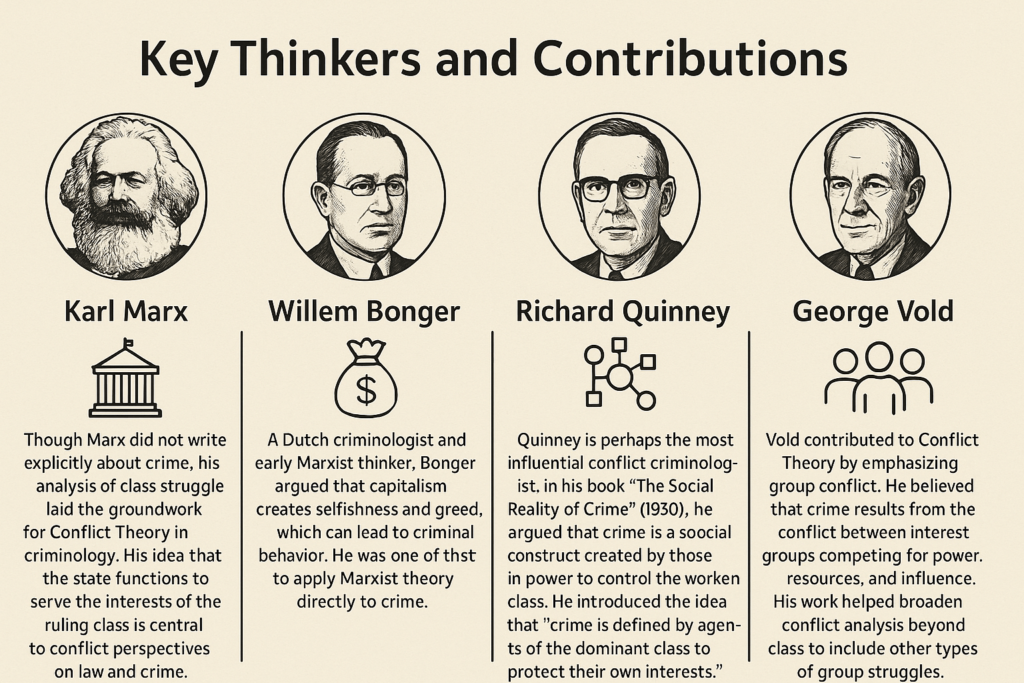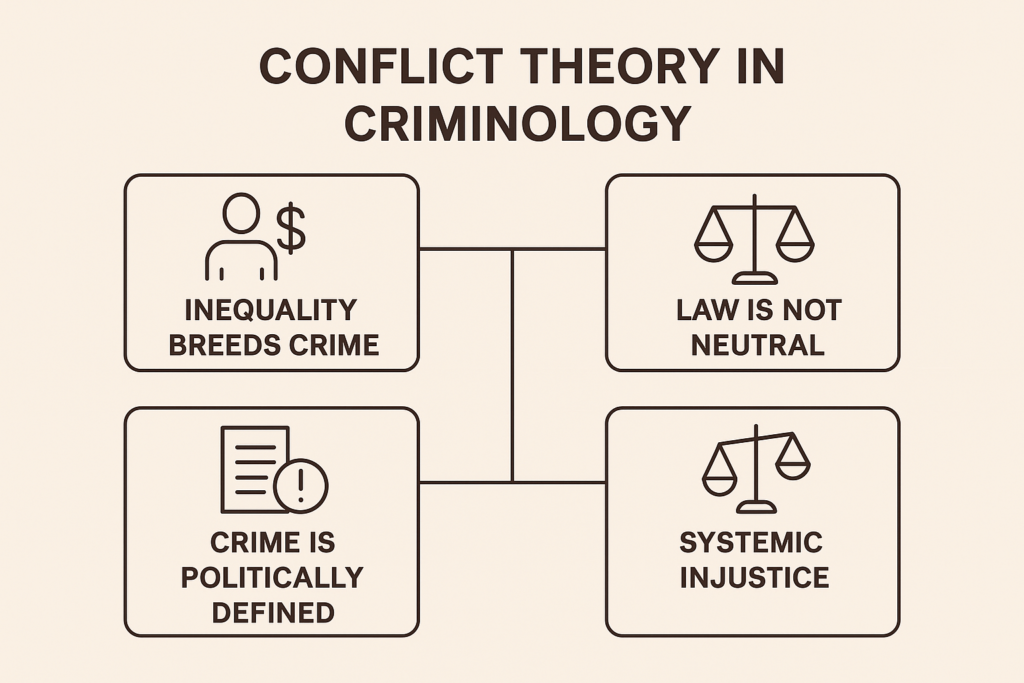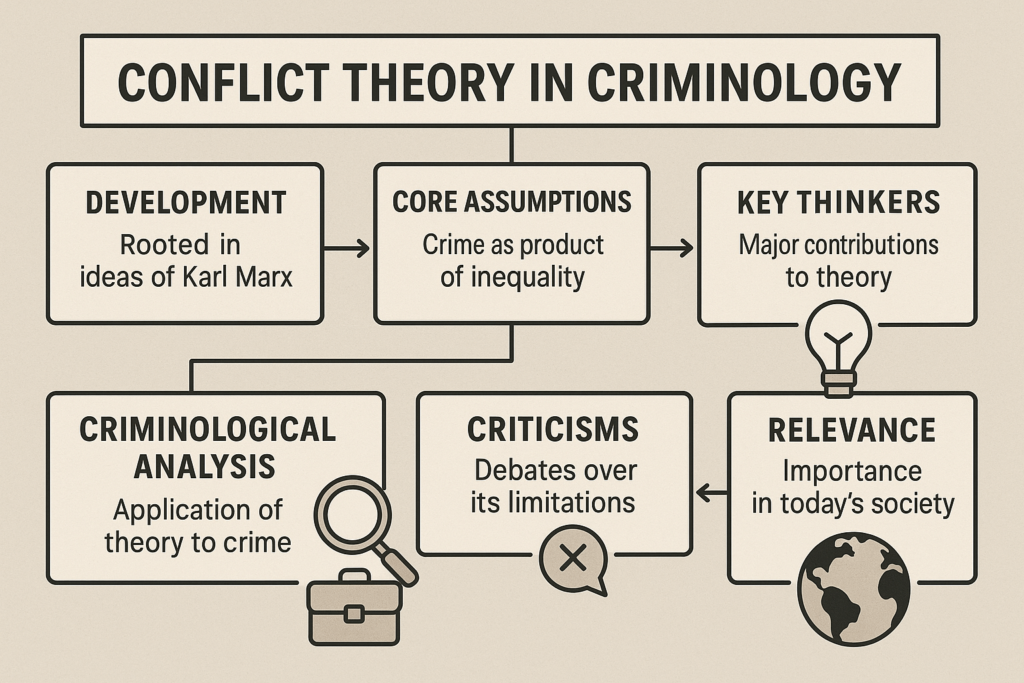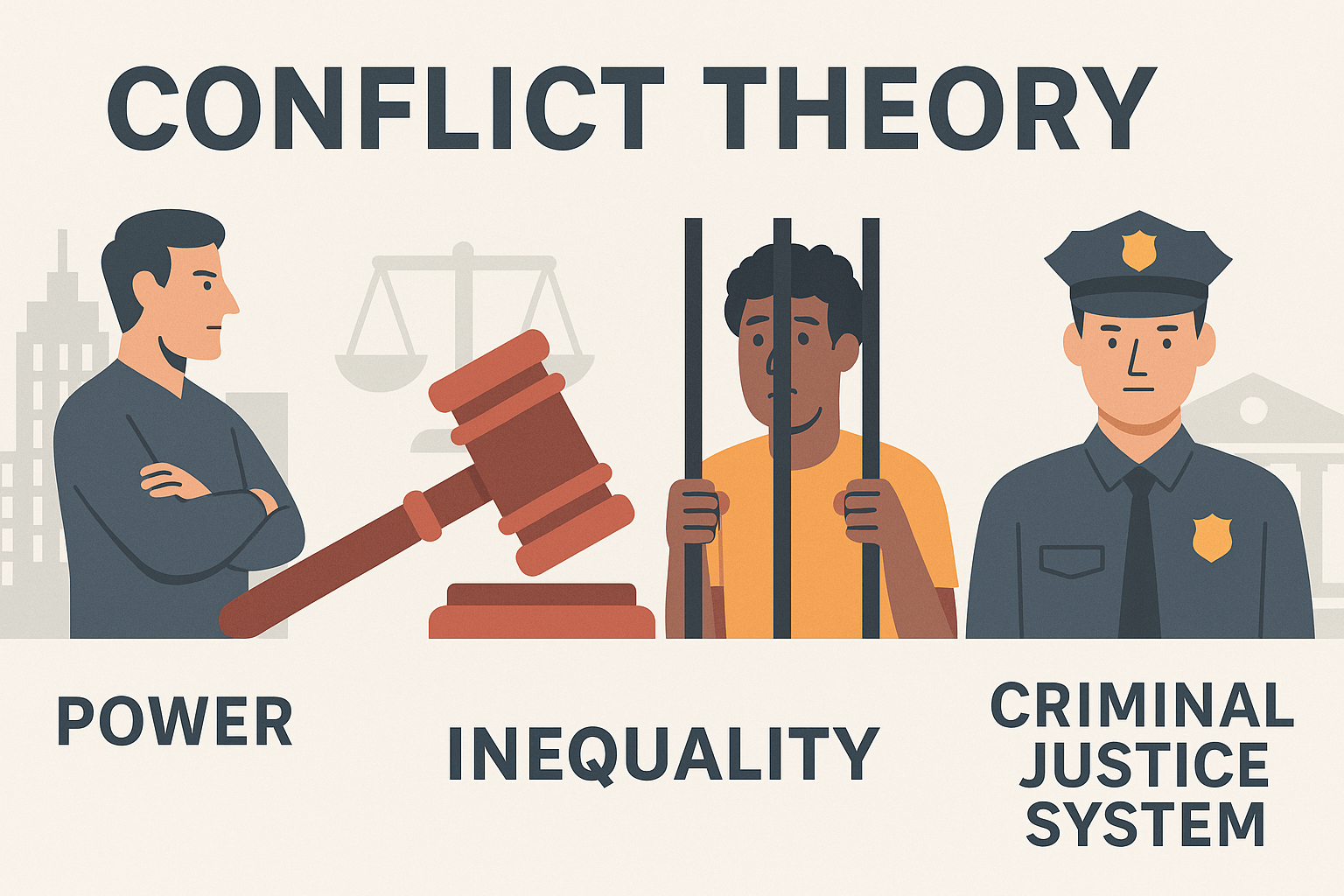Introduction To Conflict Theory
Conflict Theory is one of the most influential perspectives in the field of criminology. Rooted in sociological thought, particularly the ideas of Karl Marx, Conflict Theory suggests that crime is a product of social and economic inequality. It argues that laws and justice systems are tools used by powerful groups to control less powerful ones. This theory has reshaped how scholars and policymakers understand crime, criminal behavior, and systemic injustice.
This article explores the development of Conflict Theory, its core assumptions, contributions by key thinkers, its application in criminological analysis, criticisms, and its continued relevance in today’s socio-political landscape.
1. Theoretical Background of Conflict Theory
Conflict Theory originated in the 19th century with Karl Marx, who emphasized the role of economic structures in shaping society. According to Marx, capitalist societies are divided into two main classes: the bourgeoisie (owners of production) and the proletariat (working class). Marx believed that the state and its institutions—including the legal and criminal justice systems—exist to protect the interests of the ruling class.
In criminology, Conflict Theory evolved from this Marxist perspective and was further developed by critical theorists in the 20th century. The central argument of Conflict Theory in criminology is that crime arises from the inherent conflict between different social classes and groups, especially in stratified societies where inequality is institutionalized.
In addition to Marx’s economic interpretation of social conflict, other early sociologists like Max Weber introduced the idea that power is not limited to economic status but includes social status and political influence. This broadened the conflict approach to encompass not only class struggle but also status groups and their competing interests. Weber’s perspective highlights how groups may experience marginalization based on religion, ethnicity, or education—factors that also influence criminalization patterns.
Moreover, neo-Marxist scholars expanded the theory by focusing on ideology and hegemony. Influenced by Antonio Gramsci, these thinkers argued that the ruling class maintains dominance not just through coercion but through cultural institutions that shape public opinion. This notion helps explain why people may support laws that are contrary to their own interests, because the dominant ideology normalizes inequality.
2. Core Assumptions of Conflict Theory in Criminology
Conflict Theory in criminology is built on several foundational ideas:
- Inequality Breeds Crime: Economic and social inequalities create conditions where disadvantaged groups are more likely to engage in criminal activity.
- Law is Not Neutral: The legal system is designed to protect the interests of those in power and maintain the status quo.
- Crime is Politically Defined: Acts are labeled as “criminal” not because they are inherently wrong, but because they threaten the interests of dominant groups.
- Selective Enforcement: Law enforcement agencies disproportionately target and punish marginalized communities while ignoring the crimes of the elite.
- Systemic Injustice: The justice system is part of a broader social structure that perpetuates inequality, racism, and oppression.
Another key assumption is that criminal justice institutions are inherently biased in their structure and function. For instance, bail systems, plea bargaining, and sentencing guidelines often disadvantage those without resources or legal knowledge. Conflict theorists argue that even procedural elements of the law are crafted in a way that benefits the well-connected.
Additionally, conflict theory suggests that crime statistics themselves can be misleading. Data collected and disseminated by governmental bodies often reflect selective enforcement and may underrepresent corporate or political crimes. Therefore, crime data must be interpreted critically to understand what it reveals—and what it conceals—about power dynamics.
3. Key Thinkers and Contributions
Karl Marx
Though Marx did not write explicitly about crime, his analysis of class struggle laid the groundwork for Conflict Theory in criminology. His idea that the state functions to serve the interests of the ruling class is central to conflict perspectives on law and crime.
Willem Bonger
A Dutch criminologist and early Marxist thinker, Bonger argued that capitalism creates selfishness and greed, which can lead to criminal behavior. He was one of the first to apply Marxist theory directly to crime.
Richard Quinney
Quinney is perhaps the most influential conflict criminologist. In his book “The Social Reality of Crime” (1970), he argued that crime is a social construct created by those in power to control the working class. He introduced the idea that “crime is defined by agents of the dominant class to protect their own interests.”
George Vold
Vold contributed to Conflict Theory by emphasizing group conflict. He believed that crime results from the conflict between interest groups competing for power, resources, and influence. His work helped broaden conflict analysis beyond class to include other types of group struggles.
Other notable contributors include Jeffrey Reiman, who, in his book “The Rich Get Richer and the Poor Get Prison,” argued that the justice system is structured to appear fair while functioning in ways that reinforce inequality. His metaphor of a “Carnival Mirror” suggests that crime and punishment are distorted to protect privilege.
Howard Becker, though more aligned with labeling theory, also contributes to conflict perspectives by emphasizing the role of moral entrepreneurs—those in positions of influence who define deviance and lobby for laws that reflect their interests. This links well with the idea that definitions of crime serve dominant social forces.
Furthermore, Austin Turk introduced the concept of legal and institutional conflict, arguing that conflict emerges when groups with differing norms clash with state authority. His theory elaborates on how cultural conflict can lead to systemic criminalization of minority communities.

4. Conflict Theory and Criminal Law
One of the most powerful implications of Conflict Theory is its analysis of criminal law. According to conflict theorists:
- Laws are tools of oppression. They reflect the moral and economic values of the ruling class.
- Criminalization is selective. Behaviors of marginalized groups are criminalized more aggressively than those of the elite.
- White-collar crimes are under-prosecuted. Crimes committed by corporations and wealthy individuals are often treated with leniency, highlighting systemic bias.
- Mass incarceration serves economic and political interests. The prison-industrial complex, especially in the U.S., is seen as benefiting from the incarceration of disadvantaged populations.
One significant aspect to consider is the evolution of criminal codes over time. Conflict theorists argue that as societal values shift, the ruling class adapts legal frameworks to maintain control. For example, the criminalization of certain protest activities, especially in authoritarian regimes, is not aimed at public safety but rather at suppressing dissent.
Moreover, civil laws, such as zoning regulations or access to voting, can also be viewed through a conflict lens. While not traditionally within the criminological sphere, these laws often have indirect consequences that criminalize poverty or marginalize entire communities.
A practical example is the use of loitering laws, which disproportionately target homeless individuals and youth of color. These laws illustrate how vague legal definitions can be manipulated to enforce social hierarchies.
5. Applications of Conflict Theory in Criminology
Mass Incarceration
Conflict Theory has been widely applied to analyze mass incarceration, particularly in the United States. Scholars argue that tough-on-crime policies disproportionately affect racial minorities and the poor, reflecting broader social and economic inequalities.
Conflict Theory can also be applied to the rise of surveillance technologies. Modern tools such as facial recognition, predictive policing algorithms, and data mining are used disproportionately in low-income or minority neighborhoods. These practices suggest a new form of digital control, reinforcing systemic inequality under the guise of efficiency and security.
Police Brutality
Conflict Theory offers a framework to understand police violence as a tool of state control. It explains why certain populations—especially Black and Latino communities—are subject to excessive surveillance and force.
War on Drugs
The War on Drugs is seen through a conflict lens as a political strategy to control inner-city populations and justify the expansion of state power. The focus on drug crimes among the poor contrasts sharply with the under-enforcement of drug use among affluent groups.
Juvenile Justice System
Conflict theorists have also critiqued the juvenile justice system, noting that young people from low-income families are more likely to be labeled as delinquent and subjected to punitive interventions rather than rehabilitative ones.
6. Criticisms of Conflict Theory
While Conflict Theory provides valuable insights, it has also been criticized for several reasons:
- Overemphasis on Class: Critics argue that conflict theorists focus too narrowly on class and economic inequality, overlooking other causes of crime like psychological or cultural factors.
- Determinism: Conflict Theory is sometimes seen as overly deterministic, assuming individuals have little agency and act only in response to structural inequalities.
- Neglect of Consensus: Opponents claim the theory ignores the possibility that laws can reflect shared moral values and not just elite interests.
- Limited Empirical Support: Some empirical studies have failed to find strong evidence that legal systems are always biased in favor of the powerful, though many studies do support key tenets of the theory.
Some scholars contend that Conflict Theory can be overly monolithic, portraying society as a binary of oppressors and oppressed. This overlooks complex alliances, cross-class collaborations, and internal divisions within social classes. For example, not all members of the upper class support punitive crime policies, and not all working-class individuals oppose them.
Additionally, methodological limitations have been pointed out. Conflict Theory often relies on qualitative observations and ideological arguments rather than empirical data, making it challenging to measure or test its claims in a rigorous, scientific way.
Another criticism is that Conflict Theory sometimes fails to offer concrete solutions. While it powerfully critiques existing systems, it often lacks clear policy proposals or alternatives to the status quo, unlike restorative justice or community policing models.
7. Integrating Conflict Theory with Other Perspectives
Modern criminologists often seek to integrate Conflict Theory with other approaches, such as:
- Labeling Theory, which aligns with conflict perspectives by emphasizing how deviance is constructed by social reactions.
- Critical Race Theory, which builds on Conflict Theory by focusing on the intersections of race, law, and power.
- Feminist Criminology, which applies conflict analysis to gender-based inequalities in crime and criminal justice.
This interdisciplinary approach helps address some of the limitations of classical conflict perspectives while maintaining their critical edge.
An important development in modern criminology is the rise of intersectionality, which integrates race, class, gender, and sexuality into analyses of crime. This framework builds on Conflict Theory by recognizing multiple axes of oppression. It allows for a more nuanced understanding of how different forms of marginalization overlap in shaping criminal behavior and systemic responses.
Moreover, integration with Cultural Criminology has added depth to conflict perspectives. Cultural criminologists examine how media, subcultures, and symbolism influence perceptions of crime and deviance. This helps explain why certain crimes are sensationalized while others are ignored.
The emergence of postmodern criminology also adds complexity. Postmodernists question the very foundations of legal definitions and argue that all knowledge is situated and power-laden. This challenges conflict theorists to be more reflexive about their own positions and assumptions.
8.Cultural Conflict Theory: The Legacy of Karl Marx in Criminology
Cultural Conflict Theory in criminology explores how crime can emerge from clashes between differing cultural norms, values, and expectations, particularly between dominant and subordinate social groups. This theory gained traction in the 20th century, but its philosophical roots can be traced back to Karl Marx, whose ideas on class struggle laid the foundation for understanding societal conflict and inequality.
Karl Marx argued that society is divided into classes with inherently opposing interests—namely, the bourgeoisie (ruling class) and the proletariat (working class). In this view, the law is not a neutral or objective set of rules but a tool used by the dominant class to maintain control and suppress the working class. This concept directly influenced later criminologists, who began to see crime not just as a personal failure but as a consequence of systemic inequality and cultural domination.
Thorsten Sellin, a key proponent of Cultural Conflict Theory, extended Marxist insights by emphasizing how legal norms often reflect the values of the dominant culture, leading to conflict with minority or immigrant groups whose cultural practices may differ. According to Sellin, crime can occur when these competing value systems clash—what is legal in one group may be criminal in another.
In essence, Cultural Conflict Theory reveals that crime is not solely a matter of individual behavior but often a reflection of larger cultural and structural tensions within society. By integrating Marx’s focus on power and inequality with a cultural lens, this theory provides a powerful framework for understanding the social roots of criminal behavior.
9. Continued Relevance in the 21st Century
Conflict theory remains highly relevant in today’s world, especially as social and economic disparities continue to grow. Its analytical power extends to several modern contexts:
Social Movements
Contemporary social movements such as Black Lives Matter illustrate the ongoing systemic nature of racial injustice and state violence. Conflict theory provides a critical framework for understanding these movements as responses to structural oppression and institutional inequality.
Global Economic Inequality
In an era of increasing wealth concentration and shrinking opportunities for the middle and lower classes, conflict theory explains how legal and political institutions operate to safeguard the interests of global elites. It critiques the use of law not as a neutral arbiter but as a tool of domination.
Organized Crime and Institutional Corruption
The theory extends to corporate and political crimes, which often receive lenient treatment compared to street crimes. This double standard reinforces the idea that laws are enforced selectively to protect those with economic and political power.
Integration with Contemporary Theories
Conflict theory has evolved through integration with modern approaches, including intersectionality, which examines the overlapping effects of class, race, and gender. Its synergy with cultural theory and critical race theory has expanded its scope, enabling a more nuanced understanding of how crime is shaped by complex social narratives.
Postmodern Challenges
Postmodern thinkers call for a deeper deconstruction of identities and legal discourse, challenging even the assumptions within conflict theory itself. This push has led to more reflexive and diversified applications of the theory, ensuring its continued relevance in a rapidly changing sociopolitical landscape.

Conclusion
Conflict Theory in criminology challenges the notion of a neutral and fair justice system. By emphasizing inequality, power, and systemic bias, it provides a lens through which to analyze crime as a reflection of broader social struggles. While not without limitations, the theory remains a crucial tool for understanding the root causes of crime and the functioning of the criminal justice system in contemporary society.
As long as inequality and social conflict exist, Conflict Theory will continue to offer essential insights for scholars, practitioners, and activists committed to justice and reform.
Ultimately, Conflict Theory remains a vital lens through which to critique and understand the relationship between crime, law, and inequality. Its insights continue to influence debates on legal reform, policing practices, and social justice initiatives worldwide. As societies evolve, so too must the theory, adapting to new forms of power, resistance, and social change.


